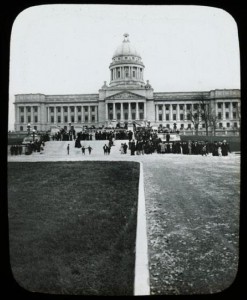Modest investment provides large return
for Kentucky, its teachers
A $1 million investment by the Kentucky General Assembly to provide public school teachers with a humane quality of life in retirement now has resulted in — more than 80 years later — Kentucky’s largest financial institution with more than $28.3 billion in assets and that annually injects more than $2.4 billion into the commonwealth’s economy from annuity benefits.
The establishment of the Teachers’ Retirement System of the State of Kentucky followed a 1936 University of Kentucky study that found teachers could not afford to retire. Because of this, older teachers continued working, in spite of some being physically or mentally disabled. Teachers were not allowed to participate in Social Security, and Kentucky schools found it difficult to attract and retain teachers.
As a result, the General Assembly created the Teachers’ Retirement System of the State of Kentucky as a defined benefit retirement plan in 1938 to provide retirement security for an at-risk population. Two years later, in 1940, operations began after the retirement system received initial funding from the General Assembly of $1 million (about $20 million in 2020 dollars). Monthly annuities have been paid to retirees ever since.
Leadership
The legislature, from the inception of TRS, put control of the institution in a board of trustees primarily elected by the membership. Day-to-day oversight is entrusted to an executive secretary. Only five people in more than 80 years have occupied the position, which is similar to a chief executive. That’s an average tenure of, now, more than 15 years.
Other benefits
Since 1964, medical insurance benefits also have been provided, and TRS, likewise, provides survivorship, life insurance and disability retirement benefits. Members receive annual statements by mail and can obtain up-to-the-minute account information through the Pathway website and mobile app.
Members
Members include local school teachers and educators at five state universities, the Kentucky Community and Technical College System and education agencies. The five universities all have experience as teacher colleges; thus their inclusion in TRS.
Why not Social Security for school teachers?
About 5% of TRS members are in Social Security — and their annuity benefits and contributions are reduced accordingly.
As mentioned in the 1936 UK study, teachers and other government workers initially weren’t allowed in Social Security. While the rules later changed to allow government workers, teachers remain outside Social Security — receiving a benefit that is about three times what the average Social Security check is at a cost that is nearly the same. By replacing Social Security, TRS allows the state to fund one retirement for teachers instead of contributing toward Social Security and some other form of retirement plan.
In the 1950s, university members voted to be in Social Security. Around that time, talk of a similar move for teachers circulated but didn’t get far amid a concern then that Social Security could be too expensive for the state.
In an Oct. 5, 1954, letter, Gov. Lawrence Wetherby wrote: “It is estimated that if the members or a majority of the teachers in the Kentucky retirement system vote to come under Social Security, the state legislature would have to find $1 million of new money annually to finance the state’s employer contribution to the Social Security fund. Under our present revenue-producing system, the legislature would encounter serious difficulty in locating a sum of new money to bring the teachers into the Social Security program.”
